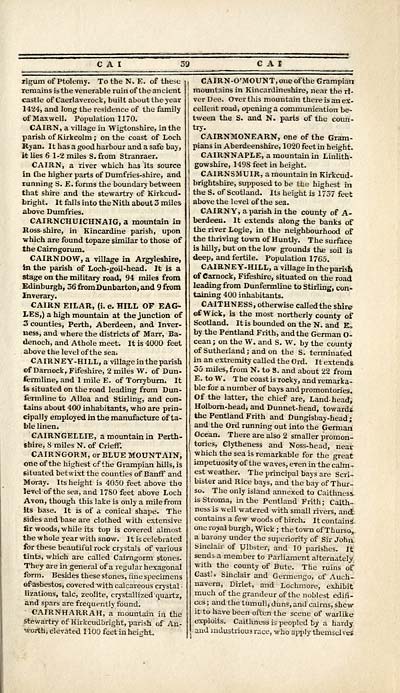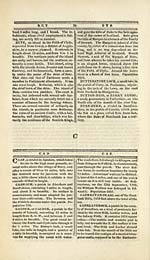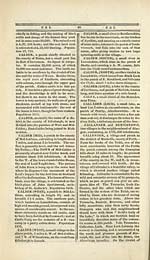Gazetteer of Scotland
(41) Page 39
Download files
Complete book:
Individual page:
Thumbnail gallery: Grid view | List view

C A I J
rigum of Ptolemy. To the N. E. of these
remains is the venerable ruin of the ancient
castle of Caerlaverock, built about the year
1424, and long the residence of the family
of Maxwell. Population 1170.
CAIRN, a village in Wigtonshire, in the
parish of Kirkcolm; on the coast of Loch
Ryan. It has a good harbour and a safe bay,
it lies 6 1-2 miles S. from Stranraer.
CAIRN, a river -which has its source
in Che higher parts of Dumfries-shire, and
running S. E. forms the boundary between
that shire and the stewartry of Kirkcud-
bright. It falls into the Nith about 3 miles
above Dumfries.
CAIRNCHUICHNAIG, a mountain in
Ross shire, in Kincardine parish, upon
which are found topaze similar to those of
the Cairngorum.
CAIRNDOW, a village in Argyleshire,
In the parish of Loch-goil-head. It is a
stage on the military road, 94 miles from
Edinburgh, 36fromDunbarton,and 9 from
Inverary.
CAIRN EILAR, (i. e. HILL OF EAG-
LES,) a high mountain at the junction of
3 counties, Perth, Aberdeen, and Inver-
ness, and where the districts of Marr, Ba-
denoch, and Athole meet. It is 4000 feet
above the level of the sea.
CAIRNEY-HILL, a village in the parish
of Darnock,Fifeshire, 2 miles W. of Dun-
fermline, and 1 mile E. of Torryburn. It
Is situated on the road leading from Dun-
fermline to Alloa and Stirling, and con-
tains about 400 inhabitants, who are prin-
cipally employed in the manufacture of ta-
ble linen.
CAIRNGELLIE, a mountain in Perth-
shire, 8 miles N. of Crieff.
CAIRNGORM, or BLUE MOUNTAIN,
one of the highest cf the Grampian hills, is
situated betwixt the counties of Banff and
Moray. Its height is 4050 feet above the
level of the sea, and 1780 feet above Loch
Avon, though this lake is only a mile from
its base. It is of a conical shape. The
sides and base are clothed with extensive
fir woods, while its top is covered almost
the whole year with snow. It is celebrated
for these beautiful rock crystals of various
tints, which are called Cairngorm stones.
They are in general of a regular hexagonal
form. Besides these stones, fine specimens
of asbestos, covered with calcareous crystal •
lizations, talc, zeolite, crystallized quartz,
and spars are frequently found.
CAIRNHARRAH, a mountain in the
stewartry of Kirkcudbright, parish of An-
worth, elevated 1 100 feet in height.
C A I
CAIRN-O'MOUNT.oneoftbe Grampian
mountains in Kincardineshire, near the ri-
ver Dee. Over this mountain there is an ex-
cellent road, opening a communication be-
tween the S. and N. parts of the coun-
try.
CAIRNMONEARN, one of the Gram-
pians in Aberdeenshire, 1020 feet in height.
CAIRNNAPLE, a mountain in Linlith-
gowshire, 1498 feet in height.
CAIRNSMUIR, a mountain in Kirkcud-
brightshire, supposed to be the highest in
the S. of Scotland. Its height is 1737 feet
above the level of the sea.
CAIRN Y, a parish in the county of A-
berdeen. It extends along the banks of
the river Logie, in the neighbourhood of
the thriving town of Huntly. The surface
is hilly, but on the low grounds the soil is
deep, and fertile. Population 1765.
CAIRNEY-HILL, a village in the parish
of Carnock, Fifeshire, situated on the road
leading from Dunfermline to Stirling, con-
taining 400 inhabitants.
CAITHNESS, otherwise called the shire
of Wick, is the most northerly county of
Scotland. It is bounded on the N. and E„
by the Pentland Frith, and the German O-
cean ; on the W. and S. W. by the county
of Sutherland; and on the S. terminated
in an extremity called the Ord. It extends
35 miles, from N. to S. and about 22 from
E. to W. The coast is rocky, and remarka-
ble for a number of bays and promontories.
Of the latter, the chief are, Land- head,
Holbom-head, and Dunnet-head, towards
the Pentland Frith and Dungisbay-head;
and the Ord running out into the German
Ocean. There are also 2 smaller promon-
tories, Clytheness and Noss-head, near
which the sea is remarkable for the great
impetuosity of the waves, even in the calm-
est weather. The principal bays are Scri-
bister and Rice bays, and the bay of Thur-
so. The only island annexed to Caithness
is Stroma, in the Pentland Frith; Caith-
ness is well watered with small rivers, and
contains a few woods of birch. It contains
one royal burgh, Wick ; the town of Thurso,
a barony under the superiority of Sir John
Sinclair of Ulbster, and 10 parishes. It
sends a member to Parliament alternately
with the county of Bute. The ruins of
Cast!. Sinclair and Germengo, of Auch-
navern, Dirlet, and Lochmore, exhibit
much of the grandeur of the noblest edifi-
ces ; and the tumuli, duns, and cairns, shew
it to have been often the scene of warlike
exploits. Caithness is peopled by a hardy
and industrious race, who apply themselves
rigum of Ptolemy. To the N. E. of these
remains is the venerable ruin of the ancient
castle of Caerlaverock, built about the year
1424, and long the residence of the family
of Maxwell. Population 1170.
CAIRN, a village in Wigtonshire, in the
parish of Kirkcolm; on the coast of Loch
Ryan. It has a good harbour and a safe bay,
it lies 6 1-2 miles S. from Stranraer.
CAIRN, a river -which has its source
in Che higher parts of Dumfries-shire, and
running S. E. forms the boundary between
that shire and the stewartry of Kirkcud-
bright. It falls into the Nith about 3 miles
above Dumfries.
CAIRNCHUICHNAIG, a mountain in
Ross shire, in Kincardine parish, upon
which are found topaze similar to those of
the Cairngorum.
CAIRNDOW, a village in Argyleshire,
In the parish of Loch-goil-head. It is a
stage on the military road, 94 miles from
Edinburgh, 36fromDunbarton,and 9 from
Inverary.
CAIRN EILAR, (i. e. HILL OF EAG-
LES,) a high mountain at the junction of
3 counties, Perth, Aberdeen, and Inver-
ness, and where the districts of Marr, Ba-
denoch, and Athole meet. It is 4000 feet
above the level of the sea.
CAIRNEY-HILL, a village in the parish
of Darnock,Fifeshire, 2 miles W. of Dun-
fermline, and 1 mile E. of Torryburn. It
Is situated on the road leading from Dun-
fermline to Alloa and Stirling, and con-
tains about 400 inhabitants, who are prin-
cipally employed in the manufacture of ta-
ble linen.
CAIRNGELLIE, a mountain in Perth-
shire, 8 miles N. of Crieff.
CAIRNGORM, or BLUE MOUNTAIN,
one of the highest cf the Grampian hills, is
situated betwixt the counties of Banff and
Moray. Its height is 4050 feet above the
level of the sea, and 1780 feet above Loch
Avon, though this lake is only a mile from
its base. It is of a conical shape. The
sides and base are clothed with extensive
fir woods, while its top is covered almost
the whole year with snow. It is celebrated
for these beautiful rock crystals of various
tints, which are called Cairngorm stones.
They are in general of a regular hexagonal
form. Besides these stones, fine specimens
of asbestos, covered with calcareous crystal •
lizations, talc, zeolite, crystallized quartz,
and spars are frequently found.
CAIRNHARRAH, a mountain in the
stewartry of Kirkcudbright, parish of An-
worth, elevated 1 100 feet in height.
C A I
CAIRN-O'MOUNT.oneoftbe Grampian
mountains in Kincardineshire, near the ri-
ver Dee. Over this mountain there is an ex-
cellent road, opening a communication be-
tween the S. and N. parts of the coun-
try.
CAIRNMONEARN, one of the Gram-
pians in Aberdeenshire, 1020 feet in height.
CAIRNNAPLE, a mountain in Linlith-
gowshire, 1498 feet in height.
CAIRNSMUIR, a mountain in Kirkcud-
brightshire, supposed to be the highest in
the S. of Scotland. Its height is 1737 feet
above the level of the sea.
CAIRN Y, a parish in the county of A-
berdeen. It extends along the banks of
the river Logie, in the neighbourhood of
the thriving town of Huntly. The surface
is hilly, but on the low grounds the soil is
deep, and fertile. Population 1765.
CAIRNEY-HILL, a village in the parish
of Carnock, Fifeshire, situated on the road
leading from Dunfermline to Stirling, con-
taining 400 inhabitants.
CAITHNESS, otherwise called the shire
of Wick, is the most northerly county of
Scotland. It is bounded on the N. and E„
by the Pentland Frith, and the German O-
cean ; on the W. and S. W. by the county
of Sutherland; and on the S. terminated
in an extremity called the Ord. It extends
35 miles, from N. to S. and about 22 from
E. to W. The coast is rocky, and remarka-
ble for a number of bays and promontories.
Of the latter, the chief are, Land- head,
Holbom-head, and Dunnet-head, towards
the Pentland Frith and Dungisbay-head;
and the Ord running out into the German
Ocean. There are also 2 smaller promon-
tories, Clytheness and Noss-head, near
which the sea is remarkable for the great
impetuosity of the waves, even in the calm-
est weather. The principal bays are Scri-
bister and Rice bays, and the bay of Thur-
so. The only island annexed to Caithness
is Stroma, in the Pentland Frith; Caith-
ness is well watered with small rivers, and
contains a few woods of birch. It contains
one royal burgh, Wick ; the town of Thurso,
a barony under the superiority of Sir John
Sinclair of Ulbster, and 10 parishes. It
sends a member to Parliament alternately
with the county of Bute. The ruins of
Cast!. Sinclair and Germengo, of Auch-
navern, Dirlet, and Lochmore, exhibit
much of the grandeur of the noblest edifi-
ces ; and the tumuli, duns, and cairns, shew
it to have been often the scene of warlike
exploits. Caithness is peopled by a hardy
and industrious race, who apply themselves
Set display mode to: Large image | Transcription
Images and transcriptions on this page, including medium image downloads, may be used under the Creative Commons Attribution 4.0 International Licence unless otherwise stated. ![]()
| Gazetteers of Scotland, 1803-1901 > Gazetteer of Scotland > (41) Page 39 |
|---|
| Permanent URL | https://digital.nls.uk/97422186 |
|---|

